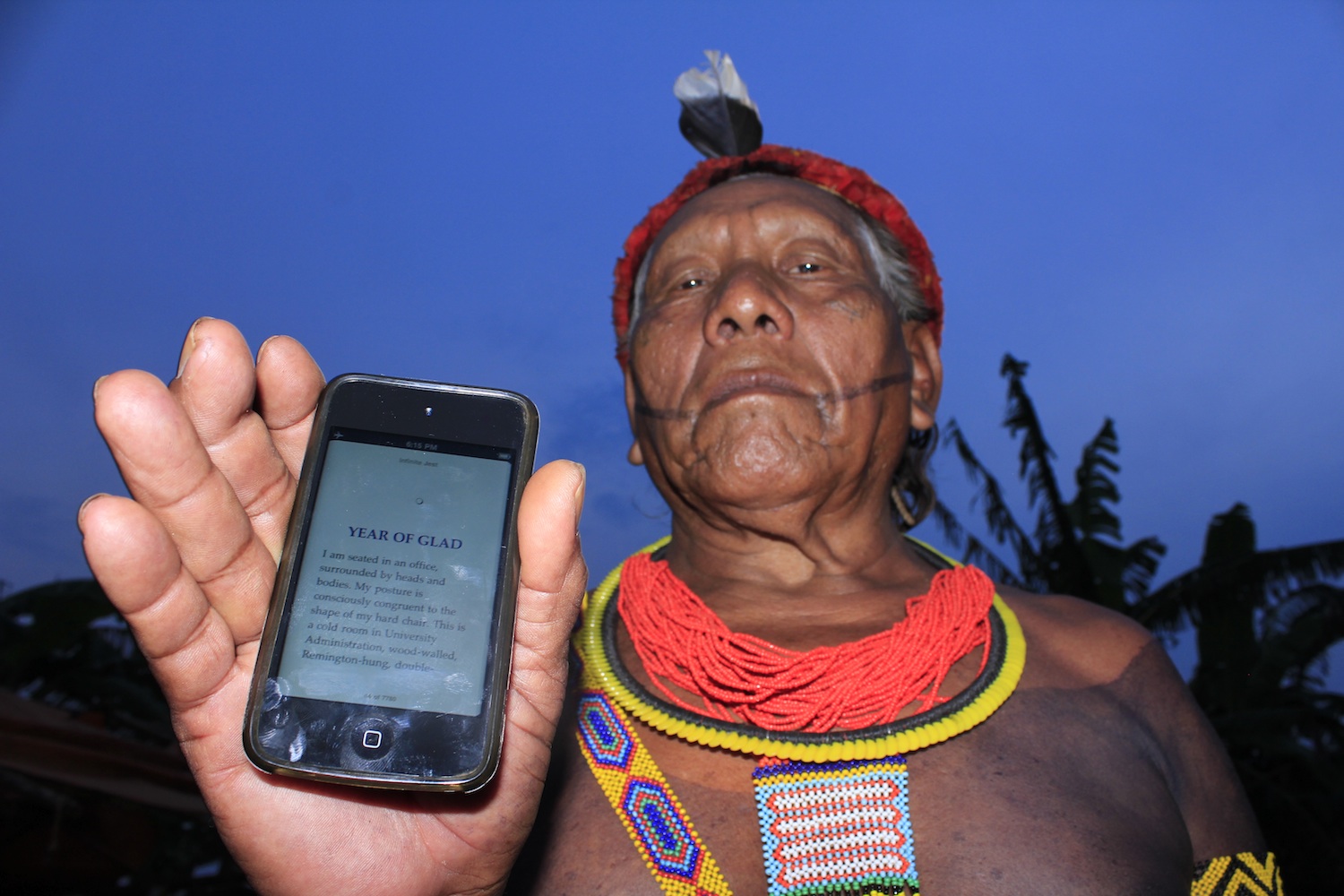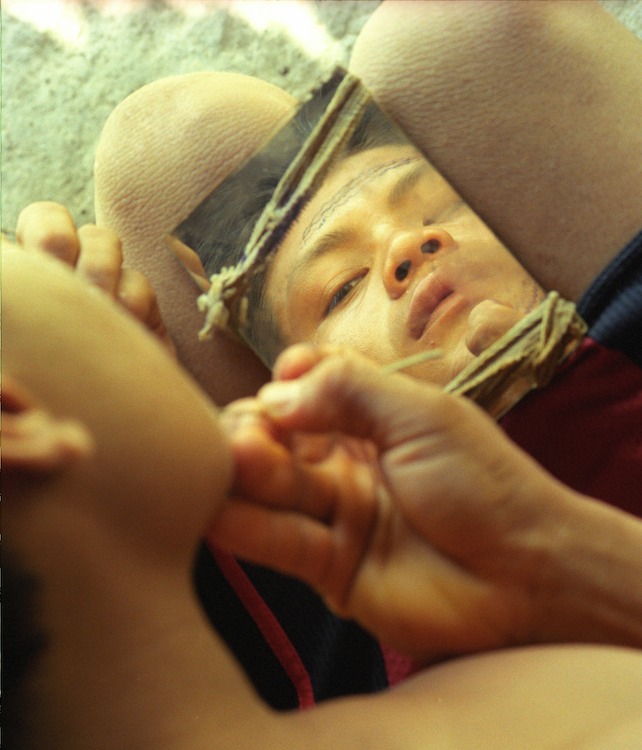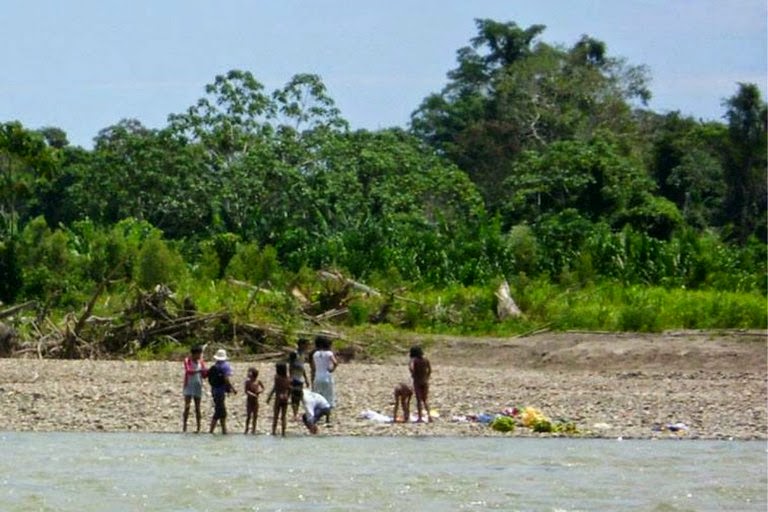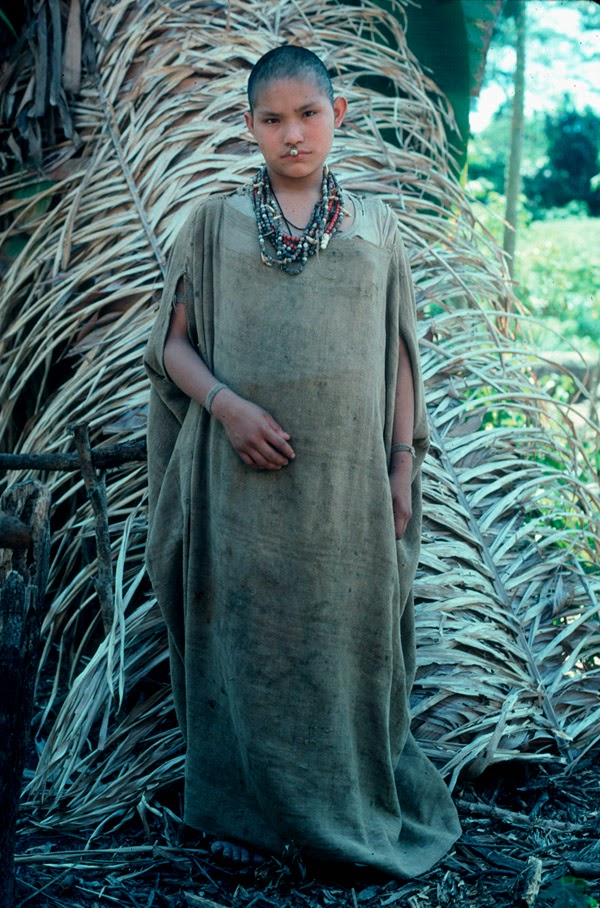David Foster Wallace lives! How else could one explain the long-distance friendship that grew up between myself and a person I have not yet met in person, and would probably never have met at all if it were not for our shared obsession with Wallace’s fiction? As an anthropologist based in Brazil, I got hooked on Wallace while reading Infinite Jest on the tiny screen of my iPod during an expedition to a Kayapó indigenous village. Caetano Waldrigues Galindo is a James Joyce specialist who teaches linguistics at the Federal University of Paraná in Curitiba, and who has just finished translating Infinite Jest into Brazilian Portuguese: he kept a blog about the year-long process.
 |
| Graça Infinita: Caetano W. Galindo's translation of Infinite Jest into Brazilian Portuguese. |
Companhia das Letras, Brazil’s premiere literary publisher, has just released a luxurious edition of Graça Infinita, Galindo's Portugese translation of Infinite Jest. Companhia das Letras first introduced Wallace to Brazilian readers in 2005 with their publication of José Rubens Siqueira’s translation of Brief Interviews with Hideous Men. Galindo has translated more than thirty books in all, including James Joyce, Thomas Pynchon, Tom Stoppard and Ali Smith, and is now busy on Wallace’s posthumous novel, The Pale King.
To celebrate the release of Wallace’s landmark novel in Brazil, I interviewed Galindo—still virtually, via email—for The Millions. Here, I post some highlights; for the full interview, see "Infinite Grace: The Millions Interviews Caetano W. Galindo":
You seem to prefer translating works and authors that are not only essentially "untranslatable," but also notoriously verbose: Joyce, Pynchon, now Wallace. Are you a masochist, or do you just enjoy intense mental activity?
Well, apart from Ulysses, all I've done is translate what my editors give me to do. Ergo, I cannot be considered a masochist: they're the sadists! But yes, this is the kind of literature I like, and thus what I read—and "write"—best. I think my publishers have found this to their liking. And yes, I really do enjoy the acrobatics. It’s kind of like chess: it’s much more fun to play against someone who's better than you are, even though you may end up losing. I like being forced to reach, to face problems I would not have conceived myself. I enjoy trying to recreate puns, acronyms, styles-within-styles, multiple voices: you know, all the hard stuff. What can I say? Back to the masochism hypothesis…
How did you first learn about David Foster Wallace's work? What else of his have you read? Why did you decide to start with Infinite Jest?
I got to know about IJ when I was deep in my Ph.D. thesis on Ulysses. It was a time in my life when I thought nothing post-Ulysses was worth the effort: I was a real bore back then! “Badness was badness in the weirdest of all pensible ways,” as good ol' Jim J. would have it. Then I heard about this huge book, and many people I respect said I should check out. And so I did. That was 2005. I got hooked. After that I read pretty much everything Wallace wrote, and everything people were writing about him. When I sat down to translate IJ, I had read the whole book twice, and was deeply familiar with Wallace's voice and “tricks.” As a matter of fact, my fascination with the book was probably what landed me the job as a translator for Companhia das Letras. André Conti, the editor at Companhia das Letras who kinda headhunted me for them, is a big Wallace fan. From the moment I was hired in 2008 we had this dream of publishing IJ in Brazil.
...
What did it feel like to spend so much time, so deep inside such a complicated plot, and such a complicated mind?
It was a fascinating process. And in this book in particular, the sensation of being "inside" someone's head (pun intended) is really overwhelming. I love the book even more today, after having unraveled and re-raveled its inner workings. I could feel the plot: I could almost touch it. But you have to remember I was not working on a regular daily schedule. When I could, I clocked 10 hours. But then, the next day, I wouldn’t have time to translate at all, since I would have papers to grade, or other things to write, or students needing help, classes to teach. I think that helped keep me safe. Wallace's (or Incandenza's) mind seems to be exactly what the book is: a beautiful labyrinth. Enchanting. But dangerous...
What do you make of IJ’s notoriously indeterminate plot? Did your interpretations or understandings affect your translation?
As for the plot: well, I'm a translator. The guy designs a labyrinth. I reproduce the design with my own bricks and mortar. It's not my job to point any ways out, if there are any! As a reader, I do have my interpretation, but that's not what matters. As I tell students all the time, the translator's job is not to find an interpretation, but to try and find all interpretations, and keep these possibilities open for this new reader who's going to have only the translation as a guide. But, back to plot, you basically follow the original steps. No biggie. There's one thing I regret, though. A student of mine, Ana Carolina Werner, pointed it out to me. The final two words of the book, referring to the tide being "way out," also suggest the possibility of exit, escape. But there was no way to keep this double entendre in the Portuguese.
...
In the European Portuguese translation, the title is rendered as Piada Infinita, while you translate it as Graça Infinita. Explain. Doesn’t graça have mystical overtones, in the sense of religious grace?
Well, that's the one I was afraid of… So here goes. First, there is the question of Brazilian vs. European usage. Both piada and graça refer to jokes, or anything that is funny. But graça also has an extended meaning cognate with English “grace,” both in the sense of religious grace and physical gracefulness. In Brazil we have an expression, ‘não tem graça’, which means both “that’s not funny” but also, “that’s not nice”; there’s also ‘sem graça’ which means “awkward,” or literally “without grace.” Europeans use piada in almost exactly the same expression, não tem piada, “that’s no joke, that’s not nice.” So in Portugal, piada has a more extended range of meanings, somewhat like graça in Brazil, whereas piada in Brazil means only "joke." So we couldn't go there. Second, and perhaps more importantly, the expression "graça infinita" was used by Millôr Fernandes in his Brazilian translation of Hamlet. We were toying with the title Infinda Graça, which uses an older, more archaic word for "infinite," and which sounded good to my ears. But the Hamlet factor was a good argument, and we ended up with Graça Infinita. Finally, you are right, graça does sound religious-y. We didn't have that many choices to begin with, and I don't think this "mystical" undertone is wrong. Is it? There may be no “God” figure central to the novel’s narrative. But, sorry! I really do like this idea that the ineffable, the mystical (as good old Ludwig W. would have it) is always there, always lurking, always tempting. So I stand by our choice!
What about Infinite Jest do you think will appeal to Brazilian readers? Is there any Brazilian author who could be considered a "soul-mate" to Wallace, in some sense? Has Wallace exerted a notable influence on Brazilian literature? What Brazilian authors, contemporary or otherwise, would you recommend to Wallace fans?
I think Graça Infinita (let me use my title, now that I’ve justified myself!) is of immense interest to anyone who is thinking about or wants to think about what it means to be a human inhabitant of this particular nook of world history. I hope readers in Brazil can see that, and can find in the book all it wants to communicate to us at this deep, human, level. As for a Brazilian “soul-mate”... well, here in Brazil we have yet to arrive at such gargantuan hubris! Our best writers, right now, seem to be more concerned with short-ish studies. But we do have a new generation of very promising prose writers. Among them we find lots of readers of Wallace. People like Daniel Galera, Daniel Pellizzari. Wallace’s influence is felt in a number of ways. Wallace is probably the best prose stylist since Pynchon or DeLillo. But like both of them, he is also a deep thinker. And what he said, through his fiction and in his essays, is already a big influence on a whole generation of writers, even here. Brazilian authors I’d recommend? Hmm.... There’s always the great Machado de Assis (I suggest Epitaph of a Small Winner)... João Guimarães Rosa, most definitely. The João Ubaldo Ribeiro of Viva o povo brasileiro. Someone more contemporary? The André Sant'Anna of O paraíso é bem bacana. Me... :-)
Have you read translations of IJ into other languages?
No. I'm only human!
...
























